For All Mankind
For a certain age group, the Moon landings were a pivotal moment in their lives as they were young enough to be excited and hadn't been jaded by the space race that had been going on all through the 1960s. My mum and dad missed it completely as they were revising for 'O' levels and just thought it was another in a long line of trips into space. NASA's Gemini project had been vying with the Russians for supremacy, and losing, through the '60s with the Soviet Union putting the first satellite, animal and human into space.
President Kennedy, speaking to a Joint Session of Congress on May 25, 1961, said:
"First, I believe that this nation should commit itself to achieving the goal, before this decade is out, of landing a man on the Moon and returning him back safely to the earth. No single space project in this period will be more impressive to mankind, or more important for the long-range exploration of space; and none will be so difficult or expensive to accomplish."
Along with a speech at Rice University, clips of which book-end this documentary, it heralded a new era in American space exploration. Committing vast amounts of money ($25 Billion, the most money committed to any project in peace time) to the Apollo project, Kennedy never saw the culmination of his ambition, which was fulfilled when the Apollo 11 crew touched down on the Moon on July 20, 1969.
Al Reinert, a journalist with a keen interest in space exploration, began visiting the NASA archives on his days off and eventually persuaded them to allow him to take the original negatives, which had been stored in liquid nitrogen, and blow them up from 16 to 35mm to make a documentary on the Apollo project. Taking 6,000 hours of footage from Apollo 8 to Apollo 17, he oversaw a painstaking process to edit the best of the material down to just over 80 minutes, showing the blast-offs, orbits and landings of the missions.
For All Mankind uses this sequence as a narrative, beginning with one of the Saturn V rockets blasting off, showing the various escapades that the astronauts had in orbit, leaving Earth's orbit and their journey to the Moon, their landing and what they did there, and finishing with a safe return to Earth.
Over all this archive footage runs a vast array of sound bites from the astronauts involved and a special soundtrack by Brian Eno, which helps to tell the story and give an other-worldly feel to the experience.
With the space race over and interest in all things space related met with apathy, the timing of this release is curious, but it is a fantastic documentary that makes you realise what a huge endeavour the Apollo project was and how important it was to our understanding of Earth's nearest neighbour.
The Disc
Extra Features
The commentary with Al Reinert and Eugene A. Cernan, commander of Apollo 17 and the last man (so far) to have walked on the Moon, is packed with information about the project and the lunar landings. Cernan is a very confident speaker and spent so long in NASA that he has plenty to impart. They make a decent team and this commentary is a really good listen.
The making of, An Accidental Gift, is a fascinating half hour featurette with even more footage than is included on the main feature and shows how the negatives are kept with Reinert explaining how the idea developed.
An old astronaut-turned painter talking about his art? Sounds boring, doesn't it? It turns out that this 45 minute piece, with a seven minute introduction about Alan Bean and his conversion from scientist to artist with a selection of his paintings, with Bean giving a story about each, is actually quite fascinating. He shows how he puts parts of his badges and the Moon dust that comes with each into the paintings and uses a boot to texture the piece. He describes what each is about and is a really easy guy to listen to.
The other two featurettes aren't so lengthy or so interesting with one showing the progression in rockets up to Saturn V and the other with 21 sound bites from the history of the Apollo missions.
As usual there is a Masters of Cinema booklet accompanying the disc which has pieces by Al Reinert and Brian Eno as well as a description of the huge audio and visual undertaking and a guide to properly viewing the film.
Unlike the film itself, the documentaries are brand new and benefit from the jump to HD and look great.
The Picture
Most of this is from very scratchy 16mm footage which has been blown up to 35mm but the quality is surprisingly good, with inky blacks in space and fine detail evident, such as the dust which is blown up when the LEM blasts off. The interpostives have gone through a huge restoration process where dirt and scratches have been removed but this has been done manually rather than a sweeping DNR process and so the fine detail remains intact.
Some of the images will be familiar as they have been widely used and have become iconic, such as the rocket blasting off and the letters U, S and A moving past the camera and Neil Armstrong jumping off the ladder and onto the lunar surface. Others had never been seen and are fascinating to watch, with astronauts doing somersaults in zero gravity, passing instruments to one another and Jim Lovett fixing the fuel unit with some gaffer tape. The most memorable are probably the little goofs where astronauts, trying to adjust to 1/6th gravity, jump and then fall over or just trip on the Moon!
The Sound
Before choosing which sound option, make sure you go on to the subtitles and select the 'identifier' option, which tells you who is speaking, otherwise you are bombarded with voices and you have no idea who's talking!
Much of the film is narration over footage but some of the material has sound, particularly the early sequence when astronauts travel to the ship and ascend to the command module in an elevator. In this, the wind blows around the room and adds to the sense of scale. The Saturn V rockets, after all, are the biggest flying vehicles ever built.
Final Thoughts
For All Mankind is a fantastic documentary that will be of great interest to anyone who was around when the great era of space exploration took place and was in the least bit interested. It's odd that this should be released on the same day as Duncan Jones' film Moon which predicts how space exploration will progress and how we will use our satellite. It's easy to see why this documentary has been lauded and the Masters of Cinema have produced another (pardon the pun) stellar release.
I'm not sure whether it really needs a high definition transfer, but this does look and sound better than the DVD though the step up isn't that great.
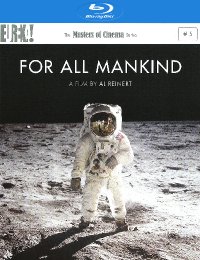

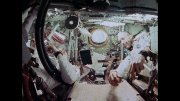

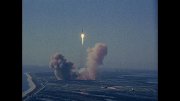


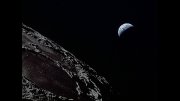
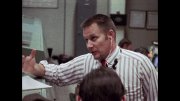
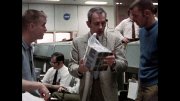
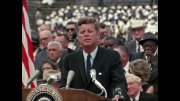
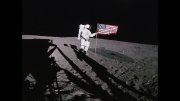
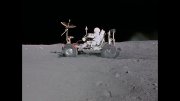

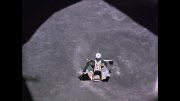
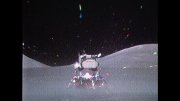
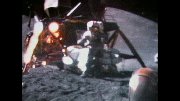












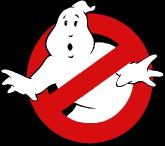
























Your Opinions and Comments
Maybe the Blu-Ray had a bit more definition but much of this footage was only 16mm to start with - and documentary 16mm which means no luxury of saturated lighting etc.
Whatever the case, I would recommend this to anyone with even a passing interest. I found myself staring up at the night sky after watching this and wondering what the whole damn purpose of it all is. It's gratifying to note that the astonauts had no better answer to this than I do!